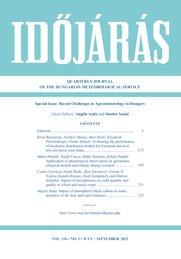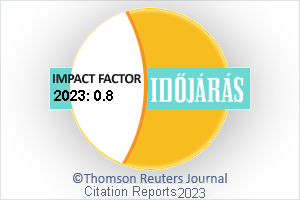IDŐJÁRÁS - angol nyelvű folyóirat
Vol. 116, No. 3 * Pages 173–236 * July - September 2012
 |
Special Issue: Recent Challenges in Agrometeorology in Hungary Guest Editor: Angéla Anda and Sándor Szalai |
 letöltés [pdf: 1775 KB]
letöltés [pdf: 1775 KB]
Editorial
Angéla Anda and Sándor Szalai
idojaras.2012.3.1
Angéla Anda and Sándor Szalai
idojaras.2012.3.1
Evaluating the performance of stochastic distribution models for European beech at low-elevation xeric limits
Ervin Rasztovits, Norbert Móricz, Imre Berki, Elisabeth Pötzelsberger, Csaba Mátyás
idojaras.2012.3.2 (p. 173–)
Ervin Rasztovits, Norbert Móricz, Imre Berki, Elisabeth Pötzelsberger, Csaba Mátyás
idojaras.2012.3.2 (p. 173–)
Application of phenological observations in agrometeorological models and climate change research
Márta Hunkár, Enikő Vincze, Ildikó Szenyán, Zoltán Dunkel
idojaras.2012.3.3 (p. 195–)
Márta Hunkár, Enikő Vincze, Ildikó Szenyán, Zoltán Dunkel
idojaras.2012.3.3 (p. 195–)
Impact of precipitation on yield quantity and quality of wheat and maize crops
Csaba Gyuricza, István Balla, Ákos Tarnawa, Ferenc H. Nyárai, Katalin Kassai, Zsolt Szentpétery and Márton Jolánkai
idojaras.2012.3.4 (p. 211–)
Csaba Gyuricza, István Balla, Ákos Tarnawa, Ferenc H. Nyárai, Katalin Kassai, Zsolt Szentpétery and Márton Jolánkai
idojaras.2012.3.4 (p. 211–)
Impact of atmospheric black carbon on some members of the heat and water balances
Angéla Anda
idojaras.2012.3.5 (p. 221–)
Angéla Anda
idojaras.2012.3.5 (p. 221–)
IDŐJÁRÁS folyóirat

Az IDŐJÁRÁS a HungaroMet Nonprofit Zrt. negyedévenként megjelenő angol nyelvű folyóirata
Megrendelhető a journal.idojaras@met.hu címen.
A szerzőknek szánt útmutató itt olvasható.
Megrendelhető a journal.idojaras@met.hu címen.
A szerzőknek szánt útmutató itt olvasható.









